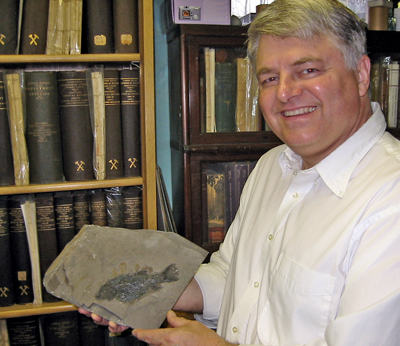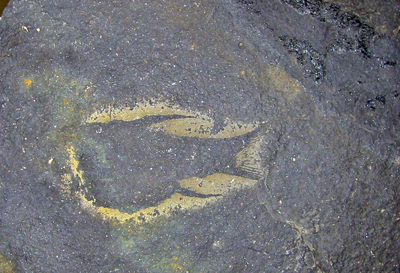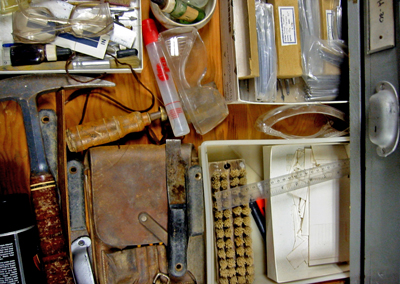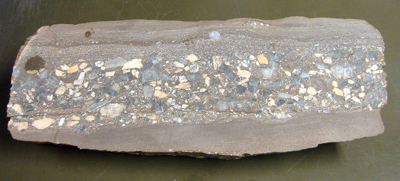Connecticut's Fossil Hunter
Fossils have cast a spell over people since early humans first dwelled in caves. In Connecticut, it's fossil fish that many find irresistible and few know more about the history of local fossil fish discoveries—and secret places where they may still be found—than paleontologist Nick McDonald of Simsbury. "Nick is probably the person who knows local fossil sites best of all," says geologist Dr. Brian Skinner of Yale.

Nick McDonald holds a favorite fossil specimen of Semionotus, a fish that was abundant in Connecticut Valley lakes in the Early Jurassic of 200 million years ago, one of many he has collected over the past nearly half century.
Nick's passion for Connecticut Valley fossils, and for the history of geologic inquiry here, is apparent from the moment you meet him. He gave me a tour of a few of his favorite fossils and geology books on Wednesday afternoon and it wasn't until hours later, when darkness finally fell, that I realized I'd lost all track of time.

"Look at this one," he boomed at one point, while sliding open a cabinet drawer. "I call this one 'The Ghost Fish.' There isn't anything left of the fish at all, really. There's just this sort of stain around where it had once been." He has fossils in all different sorts of preservation, from those that remain only as an outline, like "The Ghost Fish," to others where practically every bone, and details from eyes to bony ridges above their jaws, are preserved as a shiny black film of protein on slabs of shale.
He went on to tell a story about how he got started on what has become his life's work, reading centuries old descriptions of fossil site locations found in early American scientific literature. Too general to be of much help, he and palynologist Bruce Cornet spent weeks hiking larger areas that corresponded with early descriptions until finally stumbling on the mother lodes. In this way, he was able to find several long-lost locations such as one where the renowned paleontologist Edward Hitchcock made many discoveries of fossil insects and insect traces in the 1830s and 40s.

The tools of a lifetime spent poking around rock outcrops and searching stream bottoms for fossils and geological specimens, all neatly arranged in a cabinet in McDonald's workroom.
Of course, Nick has collected rocks over the years as well, including a few that hold dinosaur footprints. There is one marked with the impressions of what Hitchcock once referred to as "thin-toed" birds, ones he named "Leptodactylus" footprints, tracks now seen as most likely the marks of small theropod dinosaurs.
Given that he works primarily with Connecticut Valley sedimentary rocks, his favorites are those that reveal aspects about how sediments were deposited, and variations perhaps influenced by everything from passing storms to swings in the climate from relatively dry periods to what he imagines may have been monsoonal rains.

Several are quite striking, revealing where periods of gradual deposition of fine-grained sediments were suddenly interrupted by layers of much coarser conglomerate, perhaps by an intervening storm or rainy period. Others show where layers of sloppy mud seem to have been folded over on themselves by similar sorts of events.
Somewhere in all of this he wonders if there isn't a book (or books) to be written. Earlier classic works about Connecticut Valley fossils and fossil fishes long ago went out of print or out of date, and McDonald would be the perfect person to update the records. Where earlier works were written for scientists and scholars, McDonald's storytelling could bring tales of local fossils to an audience of amateur fossil fans eager to learn more about them.